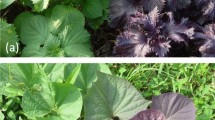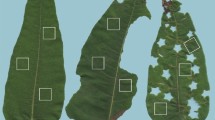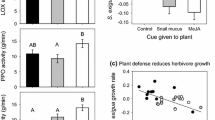Abstract
Several studies have shown changes in the patterns of damage from feeding insects associated with changes in palatability and overall consumption as a result of wound-induced chemical changes in plants. This paper describes how the pattern of feeding damage made by the larvae of Spodoptera littoralis Boisd. (Lepidoptera: Noctuidae) on tomato is affected by changes in palatability of the leaves. Two sorts of responses to leaves from plants that had received prior damage were observed. Larvae offered a choice of leaves tended to take fewer meals on leaves from previously-wounded plants than on control leaves, frequently rejecting the former after sampling them. On wounded plants this rejection behaviour was associated with a shift in feeding site towards the base of the plant. However, starved larvae offered only a single excised leaf readily ate leaves from wounded plants but took shorter meals on these leaves than on controls. Although it was not directly tested it is possible that this difference in response reflected changes in food selectivity with a differing level of satiation. The results are considered in relation to the adaptive significance of the plant of changes in within-plant distributions of herbivore damage.
Similar content being viewed by others
References
Barker AM (1990) Wound-induced changes in birch and caterpillar behaviour. Symp Biol Hung 39:441–442
Barker AM (1992) Wound-induced chemical changes in plants and their effect on the behaviour of insect herbivores. Ph.D. Thesis, University of Southampton
Blaney WM, Simmonds MSJ (1986) Learning in larval food selection: the role of plant surfaces. In: Juniper BE, Southwood TRE (eds) Insects and the plant surface. Arnold, London, pp 142–144
Bowdan E (1988) Microstructure of feeding by tobacco hornworm caterpillars, Manduca sexta. Entomol Exp Appl 47:127–136
Broadway RM, Duffey SS, Pearce G, Ryan CA (1986) Plant proteinase inhibitors: a defense against herbivorous insects? Entomol Exp Appl 41:33–38
brown ES, Dewhurst CF (1975) The genus Spodoptera (Lepidoptera Noctuidae) in Africa and the Near East. Bull Entomol Res 65:221–262
Burrows MT, Hughes RN (1991) Optimal foraging decisions by dogwhelks, Nucella lapillus (L.): influences of mortality risk and rate-constrained digestion. Funct Ecol 5:461–476
Chiang H, Norris DM, Ciepela A, Shapiro P, Oosterwyk A (1987) Inducible versus constitutive PI 227687 soybean resistance to Mexican bean beetle, Epilachna varivestis. J Chem Ecol 13:741–749
Croxford AC, Edwards PJ, Wratten SD (1989) Temporal and spatial variation in palatability of soybean and cotton leaves during wounding. Oecologia 79:520–525
Edwards PJ, Wratten SD, Cox H (1985) Wound-induced changes in the acceptability of tomato to larvae of Spodoptera littoralis: a laboratory bioassay. Ecol Entomol 10:155–158
Edwards PJ, Wratten SD, Gibberd R (1991) The impact of inducible phytochemicals on food selection by insect herbivores and its consequences for the distribution of grazing damage. In: Tallamy DW, Raupp MJ (eds) Phytochemical induction by herbivores. Wiley, New York, pp 205–222
Edwards PJ, Wratten SD, Parker EA (1992) Ecological significance of rapid wound-induced changes in plants: Insect grazing and plant competition. Oecologia 91:266–273
Fowler SV, Lawton RH (1985) Rapidly induced defences and talking trees: The Devil's advocate position. Am Nat 126:181–195
Fowler SV, Macgarvin M (1986) The effects of leaf damage on the performance of insect herbivores on birch, Betula pubescens. J Anim Ecol 55:565–574
Gibberd R (1987) Wound-induced plant responses and their consequences for insect grazing. Ph.D. Thesis, University of Southampton
Gibberd R, Edwards PJ, Wratten SD (1988) Wound-induced changes in the acceptability of tree foliage to lepidoptera: within-leaf effects. Oikos 51:43–47
Green TR, Ryan CA (1972) Wound-induced proteinase inhibitor in plant leaves: a possible defence mechanism against insects. Science 175:776–777
Harper JL (1989) The value of a leaf. Oecologia 80:53–58
Hartley SE (1988) The inhibition of phenolic biosynthesis in damaged and undamaged birch foliage and its effect on insect herbivores. Oecologia 76:65–70
Janzen DH (1978) Complications in interpreting the chemical defenses of trees against tropical arboreal plant-eating vertebrates. What is toxicity? In: Montgomery GG (ed) Ecology of arboreal folivores. Symposium of the National Zoological Park, Washington, USA, pp 73–84
Karban R (1985) Resistance against spider mites in cotton induced by mechanical abrasion. Entomol Exp Appl 37:137–141
Karban R, Myers JH (1989) Induced plant responses to herbivory. Annu Rev Ecol Syst 20:331–348
Nelson CE, Walker-Simmons M, Makus D, Zuroske G, Graham J, Ryan CA (1983) Regulation of synthesis and accumulation of proteinase inhibitors in leaves of wounded tomato plants. In: Hedin PA (ed) Host plant resistance to insects (Symposium 208). American Chemical Society, Washington, pp 103–122
Newman JA, Penning PD, Parsons AJ, Harvey A, Orr RJ (1994) Fasting affects intake behaviour and diet preference of grazing sheep. Anim Behav 47:185–193
Parker MA (1984) Local food depletion and the foraging behaviour of a specialist grasshopper, Hesperotettix viridis (Orthoptera: Acrididae). Ecology 65:824–835
Reynolds SE, Yeomans MR, Timmins WA (1986) The feeding behaviour of caterpillars (Manduca sexta) on tobacco and artificial diet. Physiol Entomol 11:39–51
Roa R (1992) Design and analysis of multiple-choice feeding-preference experiments. Oecologia 89:509–515
Sabelis MW (1990) How to analyse prey preference when prey density varies? A new method to discriminate between the effects of gut fullness and prey type composition. Oecologia 82:289–298
Schultz JC (1983) Habitat selection and foraging tactics of caterpillars in heterogeneous trees. In: Denno RS, McClure MS (eds) Variable plants and herbivores in natural and managed systems. Academic Press, New York, pp 61–90
Silkstone BE (1987) The consequences of leaf damage for subsequent insect grazing on birch (Betula spp.). A field experiment. Oecologia 74:149–152
Silkstone BE (1989) Wound-induced changes in the chemistry of birch foliage and their ecological consequence. Ph.D. thesis, University of Southampton
Simpson SJ, Simmonds MSJ, Blaney WM, Jones JP (1990) Compensatory dietary selection occurs in larval Locusta migratoria but not Spodoptera littoralis after a single deficient meal during ad libitum feeding. Physiol Entomol 15:235–242
Sokal RR, Rohlf FJ (1981) Biometry, 2nd edn. Freeman, New York
Tallamy D (1985) Squash beetle trenching behaviour: an adaptation against induced cucurbit defenses. Ecology 66:1574–1579
Tallamy DW, Raupp MJ (eds) (1991) Phytochemical induction by herbivores. Wiley, New York
Van Alstyne KL (1988) Herbivore grazing increases polyphenolic defenses in the intertidal brown alga Fucus distichus. Ecology 69:655–663
Waldbauer GP (1968) The consumption and utilization of food by insects. Adv Insect Physiol 5:229–288
Waldbauer GP, Cohen RW, Friedman S (1984) Self-selection of an optimal nutrient mix from defined diets by larvae of the corn earworm, Heliothis zea (Boddie). Physiol Zool 57:590–597
Whitham TG (1983) Host manipulation of parasites: within-plant variation as a defense against rapidly evolving pests. In: Denno RF, McClure MS (eds) Variable plants and herbivores in natural and managed systems. Academic Press, New York, pp 15–41
Wolfson J (1991) The effects of induced plant proteinase inhibitors on herbivorous insects. In: Tallamy DW, Raupp MJ (eds) Phytochemical induction by herbivores. Wiley, New York, pp 223–244
Wratten SD, Edwards PJ, Dunn I (1984) Wound-induced changes in the palatability of Betula pubescens and B. pendula. Oecologia 61:372–375
Wratten SD, Edwards PJ, Barker AM (1990) Consequences of rapid feeding-induced changes in trees for the plant and the insect: Individuals and populations. In: Watt AD, Leather SR, Hunter MD, Kidd NAC (eds) Population dynamics of forest insects. Intercept Ltd, Andover, Hampshire, UK, pp 137–145
Zangerl AR (1990) Furanocoumarin induction in wild parsnip: evidence for an induced defense against herbivores. Ecology 71:1926–1932
Author information
Authors and Affiliations
Rights and permissions
About this article
Cite this article
Barker, A.M., Wratten, S.D. & Edwards, P.J. Wound-induced changes in tomato leaves and their effects on the feeding patterns of larval lepidoptera. Oecologia 101, 251–257 (1995). https://doi.org/10.1007/BF00317291
Received:
Accepted:
Issue Date:
DOI: https://doi.org/10.1007/BF00317291




